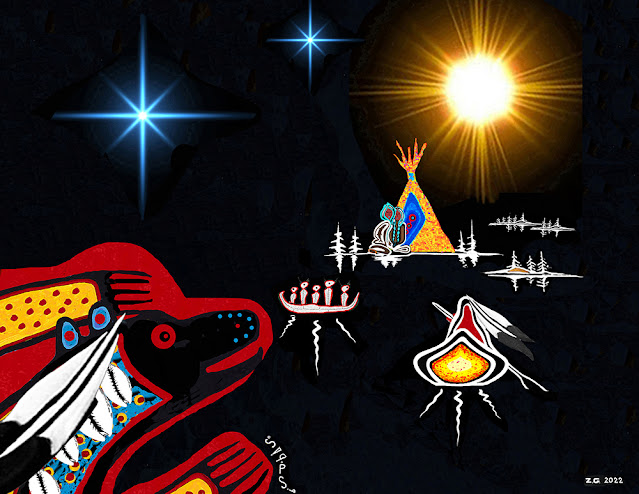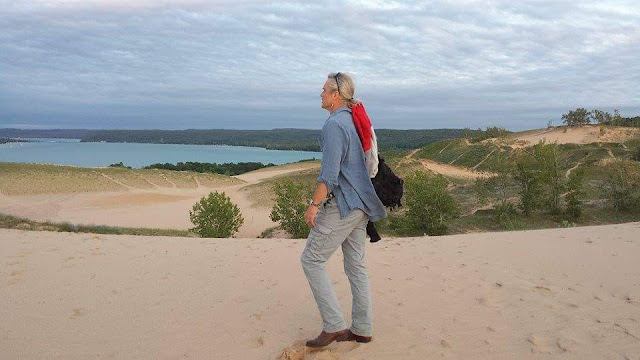"Sleeping Bear and Her Children"
A love story told by Zhaawano Giizhik
It's a collection of love stories written and provided with jewelry images and illustrations of artwork by myself and kindred artists. The stories are based on aadizookaanan (traditional stories) of our People, the Ojibwe Anishinaabeg of Gaa-zaaga'eganikaag, the land of many lakes - the Great Lakes area of North America.
These narratives are of a sacred, healing nature and told within a romantic context, their allegorical themes often provided with a personal touch.
The following tale is a zaagi'iwewi-aadizookaan (sacred love story). It is narrated in the form of a frame story, in this case several metaphoric tales of a traditional, sacred nature placed within a larger story that has also embedded in it some autobiographical elements. The characters that figure in the narrative of Standing Firm are actually based on real persons.
I am most grateful to my friend Charles J. Lippert who, in the course of writing this story, once again shared with me his incredible knowledge of the Anishinaabe language and culture.

________________________________________________________________________
The Story of Standing Firm
Once there lived a girl in an Ojibwe village who was named Ashkibag (monarch butterfly) by her parents at birth. Her doodem was Name, the clan of the Sturgeon People. When she turned 15 summers she had a dream of a bear and from then on her name was Mashkawigaabawiik (“Standing Firm”).
As Mashkawigaabawiik turned into a young woman she fell in love with a man from another Nation, which dwelled to the north from where the Ojibweg lived. His village was located across the same lake on whose borders her parent's wiigiwaam (lodge) stood. At night, she would hear across the water of the lake the sound of a hand drum, accompanied by the most beautiful voice she had ever heard. The voice reminded her of the melancholic cries of the loons that lived abundantly on the lake that stretched out in front of her. Although she didn’t know the meaning of the words of the song - it was sung in a language she did not understand - she imagined it to be a love song, sung especially for her. Which, in fact, was indeed the case!
_________________________________________________________________________________
________________________________________________________________________________
One day Mashkawigaabawiik decided to leave her husband, and she secretly packed her needles and beads and art supplies and a few clothes, and she stole away from his side in the middle of the night. With a heavy heart because she had to leave her children, but determined to return to the village of her family where she once lived carelessly and free like a butterfly, she steered her canoe toward the shore of the other side, and she sang a last song for her husband.
“How much I craved freedom
You once owned me, I was
flying free in a closed world
you did not see I was sad.
This day through a smoke hole
I was called to come home
a smell oh so fragrant
false dreams are now gone.
Afraid to take steps
to freedom of flight
I looked for many hours
by day and cold nights.
Owner I see you
your vigil in the shadow
loyalty now questioned
And now I must go.
There are no butterfly nets
that can stop what's begun
for it is time for freedom
it is time for the sun.
Do not try to stop them
the beautiful sounds
of wings so softly beating
from sky to the grounds.
When we try to hang on
to something we own
turns out we then hurt them
the loves we have known.
Lost now are the colors
I brought into your life
find yourself a new one
and cause her no strife.
Trust, love, and respect
can go a long way, yet
your actions are your choice
by the end of the day...”**
Mashkawigaabawiik’s mother, whose name was Aazhawash (“Wafted Across”), sensing her daughter’s feelings of guilt and her longing for her children, decided to offer her council by sharing her own outlook on life, after which she concluded her reflection in the form of an aadizookaan (metaphoric story of a sacred nature).
“Someday,” Aazhawash told her daughter, “when you will walk happily with this man named Wenoondaagoziwid-webaashi, you will find the strength in your heart needed to return to the Ginishtinoo village on the other side of the lake and visit your children. One day, they will have children too. You must tell them the sacred story that I will tell you today. Tell them to love their children unconditionally and always to remember to love their children like you have always loved yours. And tell them the importance of determination and faith in everything they do, no matter the curves they encounter on the road of their journeys. Tell them to pursue their dreams and never give up, no matter what others might say about the choices they make in life.”
“One thing I have learned on this life’s journey, indaan (my daughter), is not to pray for strength for oneself or for those we love. To pray for strength is to ask that the road ahead be hard. It is only through rough roads and hard lessons that we gain strength.
Once we are standing outside under the stars not praying for strength, it is then that we are at a loss for words.
We find that we really must find out more about ourselves. That the Great Mystery placed us on the earth as individuals and that we are on our own paths, responsible solely for ourselves and our children and not for how or what others think, or the path of life that is theirs to walk.
We cannot live to appease those around us for it is then that we get lost in someone else’s path and that small empty place inside ourselves begins to grow.”
________________________________________________________________________________
________________________________________________________________________________
After a short pause Aazhawash continued:
"You must always remember to walk your own road and follow your own dreams indaan; walk someone else’s road and follow someone else’s dreams and it will lead you nowhere. Fly like the butterfly; stand firm like the bear.”
“Many summers ago, before you left us to live in the nisawa`igan (tipi) of the man who lives across the lake, you undertook a makadekewin (vision quest). You fasted in solitude in a glade in the middle of the forest. Surrounded by tall cedar trees you fasted until after four days and three nights you received your first waaseyaabindamowin (life-guiding dream). In this dream, a bear rested his paw on your leg and told you that you are destined to walk the spiritual road as a mazinibii`igekwe, someone who has received the gift of creating images, whose able hands makes visible to others the world of the ancestors, thus reflecting the manidoo-minjimandamowin, or Spirit Memory, the collective knowledge of the People."
“It is important that you always remember it was the bear, a mystic dream visitor and respected teacher of mankind, who gave you spiritual and artistic powers and the higher mental capacities needed for judgment and decision-making in your later life.”
________________________________________________________________________________
The Sacred Tale of Sleeping Bear
Giiwenh, so the story goes.”
Dream Of The Bear
The Reunion
travel truly alone
gone on their wings
never known at the time
feelings of great loss
no longer are mine
Smiles are inside me
to see plain as the day
as those butterflies took
the bad dreams away
Little child wanders now
in the rays of the sun
with love deep inside
and so happy to run
in new fields of flowers
so big and so bright
I see the monarchs
what a beautiful sight
No one ever does
travel truly alone.”*
Once we are standing outside under the stars not praying for strength, it is then that we are at a loss for words.
We learn that we cannot live to appease those around us for it is then that we get lost in someone else’s path and that small empty place inside ourselves begins to grow.
Remember to walk your own road and follow your own dreams niniijaanisag; walk someone else’s road and follow someone else’s dreams and it will lead you nowhere.
You must always fly like the butterfly and stand firm like the bear.
Ahaaw niniijaanidog, n'gad aadzooke (Now my children, I will tell a sacred story…)”
Click here to read the third episode in the series "Love stories from the Land of Many Lakes": "A Pink Rose."
* Ginishtinoo: An Ojibwe word used for the Ininewak, or Cree People.
**Poetry by Simone McLeod.
Jewelry and jewelry photography by Zhaawano Giizhik. The jewelry are storytelling tools and not for sale.
- Storytelling ring set "Noozhekwa-manidoo" ("Spirit Of The She-Bear"), overlay 14K yellow and red gold on 14K warm yellow gold and 14K palladium white gold and red gold on 14K warm yellow gold.
- Pen-and-ink drawing by Zhaawano Giizhik: Ajijaak Nagamon (Song of the Big Sandhill Crane") (2022).
- Crayon drawing on paper by Simone McLeod: detail of "Twins in Sweat Lodge Womb" (2013).
- Pen-and-ink drawing by Zhaawano Giizhik: Naazikodaadiwin ("The Reunion") (2022).
Painting, acrylic on canvas by Simone McLeod: detail of "Journey To The Dawn Land" (2012).
________________________________________________________________________________
About the author/artist and his inspiration:
My name is Zhaawano Giizhik.
As an American (non-commercial) artist and jewelry designer currently living in the Netherlands, I like to draw on the oral and pictorial traditions of my Ojibwe Anishinaabe ancestors from the American Great Lakes area. For this I call on my manidoo-minjimandamowin, or "Spirit Memory"; which means I try to remember the knowledge and the lessons of my ancestors.
The MAZINAAJIMOWINAN or ‘‘pictorial spirit writings’’ - which are rich with symbolism and have been painted throughout history on rocks and etched on other sacred items such as copper and slate, birch bark and animal hide - were a form of spiritual as well as educational communication that gave structure and meaning to the cosmos. Many of these sacred pictographs or petroforms – some of which are many, many generations old - hide in sacred locations where the manidoog (spirits) reside, particularly in those mystic places near the coastline where the sky, the earth, the water, the underground and the underwater meet.










Beautiful! And profound. I will take that story into me.
ReplyDeleteThank you Laura! I am glad you like the story.
Delete